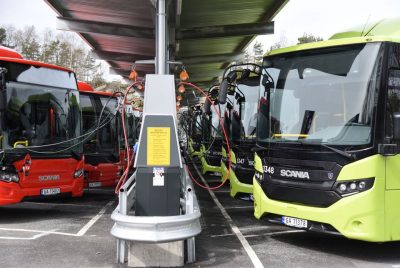UPDATED: Commuters, students and everyone else who regularly travel by bus in and around Oslo need to find other means of transport, or just stay home. A strike by nearly 4,000 frustrated bus drivers has set off commuter chaos and more Corona infection alarms, and the strike was set to spread quickly nationwide.

“Don’t travel unless you absolutely must, hold your distance if you do, and use face masks as recommended by health care officials,” wrote the Oslo public transport organization Ruter in a press release after the strike was called early Sunday morning. Ruter, along with bus systems Brakar and Østfold kollektivtrafikk, have been hit by the strike in Oslo and much of the surrounding area in the southeastern county of Vika.
By midday Monday, the trade union federations behind the strike warned they would pull an additional 4,500 bus drivers off the job on Saturday if their demands aren’t met. Then the strike would spread to Vestland, Trøndelag, Rogaland and Finnmark, plus parts of Nordland and Agder.
The bus drivers, who literally have helped keep wheels turning during the Corona crisis, say they felt forced to strike when employers’ organizations NHO Transport and Spekter refused to meet demands for higher pay and better working conditions. The bus drivers complain that they’re a chronically low-paid labour group even at a time when public transportation has had more investment than ever before. They want to be paid in line with other industrial workers in Norway.
They’re also upset about what’s called delt skift (split shift), which their unions say can keep bus drivers on the job for up to 70 hours a week but only get paid for half. That’s because the drivers are on duty early and late in the day and “forced” to be free in the middle of the day, making it difficult to combine work and family life.
“The drivers are exhausted by this, and want a work day where it can be possible to live a normal life and make Norwegian roads safer,” states one of four unions involved in the strike, Fellesforbundet. Other unions involved include Fagforbundet, Yrkestrafikkforbundet and Jernbaneforbundet, which had been negotiating collectively with the employers’ organizations until talks broke down during the weekend.
“The employers have not been willing to contribute to finding solutions for old agreements and ongoing irritations,” stated Stein Guldbrandsen, who led negotiations for Fagforbundet. He claimed that the employers have also been “misusing the Corona situation” to exempt themselves from earlier labour agreements.
Employers, meanwhile, claim that the unions’ pay demands, to narrow the wage gap between bus drivers and industrial workers, will cost up to NOK 40,000 more per year per driver. NHO calls that an “unreasonable” demand, while also pointing to how the nature of public transport has higher demand during commuter rush hours and less in the middle of the day.
Since the strike is a legal labour dispute, other public transport sectors such as trains, trams, ferries or the metro system can’t expand their own capacity. That meant many commuters felt forced to crowd onto the other forms of public transport Monday morning, much to the despair of health care and government officials already battling new outbreaks of the Corona virus in Oslo.
“There’s all reason to fear that the strike can contribute to increased infection,” Oslo’s city government leader Raymond Johansen told various media outlets on Sunday. “I’m worried about overcrowding and hope the strike will be short.”
Johansen represents the left wing of the Labour Party, which has long championed the working class and the right to strike. Now, however, he’s alarmed that it would be difficult if not impossible to trace any new outbreaks of Covid-19 if infection occurs on over-crowded public transport. He also noted that many of the city’s own 53,000 employees can’t simply opt for using a home office, since they work in the schools, nursing homes and day care centers, for example. Many will have no choice but to drive to work if they have a car, something the city has long discouraged.
Adding to the chaos Monday morning was a group of around 80 climate activists, who blocked a busy downtown intersection in Oslo Monday morning to protest the Norwegian government’s oil policies. State broadcaster NRK reported how they held up banners reading “Pardon the inconvenience, but we’re trying to save the world.” Police resorted to carrying away several of the activists, who had chained themselves to together.
NewsInEnglish.no/Nina Berglund

